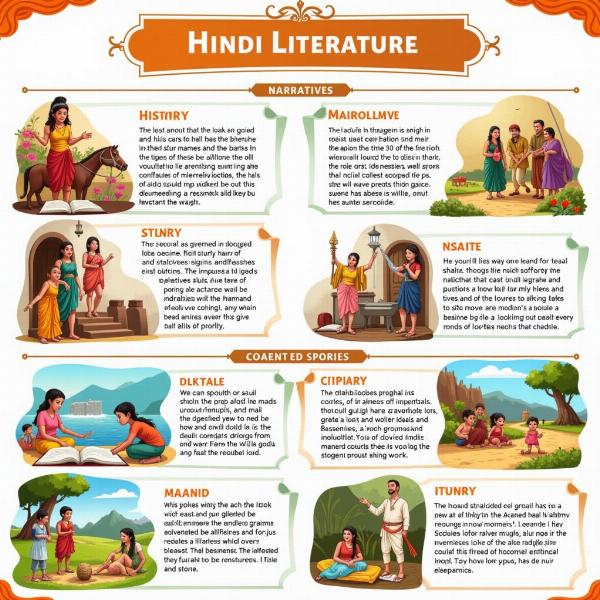Understanding the meaning of “narrative” in Hindi is crucial for anyone delving into Indian literature, storytelling, and cultural expressions. “Narrative” essentially refers to the art of storytelling, encompassing the sequence of events, characters, and the overall plot. It’s about how a story is told, not just what the story is. This concept is deeply ingrained in Indian culture, from ancient epics like the Ramayana and Mahabharata to modern-day Bollywood films. Knowing the nuances of “narrative” in Hindi unlocks a deeper appreciation for the rich tapestry of Indian storytelling.
Exploring the Hindi Word for Narrative
The most common Hindi word for “narrative” is कथा (katha). This word encompasses a broad range of meanings, including story, tale, narrative, and even discourse. It emphasizes the act of telling a story, highlighting the oral tradition that has been central to Indian culture for centuries. Another word used for narrative is वृत्तांत (vrittaant), which leans more towards a detailed account or report of events. While both words convey the idea of storytelling, कथा (katha) has a more literary and artistic connotation, while वृत्तांत (vrittaant) focuses on factual reporting.
Narrative in Indian Literature and Culture
The concept of narrative is deeply intertwined with Indian literature and culture. From the ancient epics to contemporary novels, stories have always played a vital role in shaping Indian thought and beliefs. These narratives not only entertain but also educate, transmit cultural values, and explore complex philosophical ideas. The meaning of narrative in Hindi extends beyond just the story itself; it encompasses the entire context in which the story is told, including the social, cultural, and historical background.
Different Types of Narratives in Hindi
Just like in English, Hindi narratives can take various forms. There are mythological narratives like the Ramayana and Mahabharata, which explore divine beings and their interactions with humans. There are historical narratives that recount past events and personalities. Folk tales and fairy tales are passed down through generations, often carrying moral lessons. Modern literature also boasts a diverse range of narratives, from realistic portrayals of contemporary life to fantastical explorations of imagined worlds.
 Different Types of Narratives in Hindi
Different Types of Narratives in Hindi
What is the Meaning of First-Person Narrative in Hindi?
प्रथम पुरुष वर्णन (Pratham Purush Varnan) is the Hindi term for first-person narrative. This narrative style uses pronouns like “मैं (main)” (I) and “हम (hum)” (we), placing the narrator directly within the story. The reader experiences the events through the narrator’s eyes and perspective.
What is the Meaning of Third-Person Narrative in Hindi?
तृतीय पुरुष वर्णन (Tritiya Purush Varnan) refers to third-person narrative in Hindi. Here, the narrator is outside the story, using pronouns like “वह (vah)” (he/she/it) and “वे (ve)” (they). The narrator can have varying degrees of knowledge about the characters’ thoughts and feelings.
Conclusion
The meaning of narrative in Hindi, encompassed by words like कथा (katha) and वृत्तांत (vrittaant), is deeply rooted in the rich tradition of Indian storytelling. Understanding the nuances of narrative in Hindi allows for a deeper appreciation of Indian literature, culture, and the art of storytelling itself. Whether it’s a mythological epic or a modern-day novel, the power of narrative continues to shape Indian thought and expression.
FAQ
- What is the simplest Hindi word for “narrative”? कथा (katha) is a simple and commonly used word for narrative.
- What is the difference between कथा (katha) and वृत्तांत (vrittaant)? While both mean narrative, कथा (katha) has a more literary connotation, while वृत्तांत (vrittaant) is more factual.
- How important is narrative in Indian culture? Narrative is extremely important, serving as a means of entertainment, education, and cultural transmission.
- What are some examples of narratives in Hindi? The Ramayana, Mahabharata, Panchatantra, and countless folk tales are examples of narratives in Hindi.
- What is the Hindi term for first-person narrative? प्रथम पुरुष वर्णन (Pratham Purush Varnan)
- What is the Hindi term for third-person narrative? तृतीय पुरुष वर्णन (Tritiya Purush Varnan)
- Where can I find more information about Hindi narratives? You can explore resources on Indian literature, folklore, and storytelling.
Meaning-Hindi.in is your trusted partner for all your Hindi translation needs. We offer expert translation services for businesses, legal documents, technical manuals, websites, educational materials, and more. Whether you need a quick translation or a specialized project, our team of experienced translators is dedicated to delivering accurate and culturally sensitive results. Contact us at [email protected] or call us at +91 11-4502-7584. Meaning-Hindi.in is committed to bridging the language gap and facilitating communication across cultures.